MXA VENTURES INTO SUPERMOTO ON AN ITALIAN TM SMX 450FI
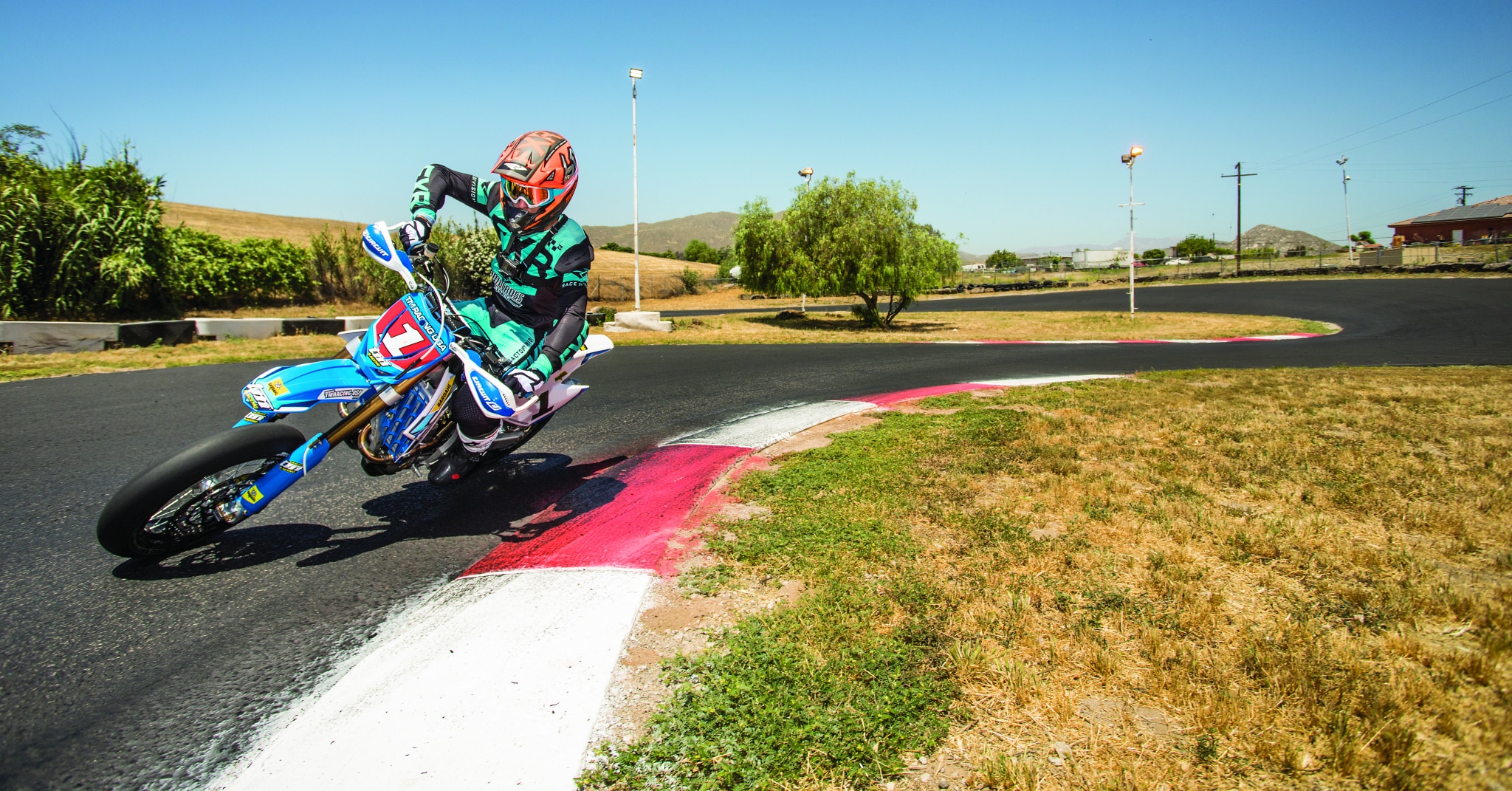
WE RIDE A TRUE-TO-LIFE TM SMX 450FI SUPERMOTO MACHINE
BY JOSH MOSIMAN
Supermoto was created to be the ultimate challenge for motorcycle riders by combining road racing, flat track and motocross into one racing discipline. Based on the ABC “Superbikers” television show, which was filmed at Carlsbad Raceway and featured Steve Wise, Eddie Lawson, Danny Chandler, Kent Howerton and a host of dirt track, motocross and road race stars, the sport came into its prime in the early 2000s when the AMA started its AMA Supermoto Championship. When the X Games jumped on the Supermoto bandwagon, it looked like the sport was on the verge of taking off. The 2000s were the heyday of Supermoto, and it attracted stars like Jeff Ward, Doug Henry, Jeremy McGrath, Travis Pastrana, Chad Reed, Kurt Nicoll, Micky Dymond, Ben Bostrom, Nicky Hayden, Carey Hart, Mike Metzger and more.
Red Bull got involved, the pits were packed with semis, and the racing attracted a unique blend of top-tier athletes coming from motocross, road racing and freestyle to face off in the hybrid sport. Some guys were serious and competed in the whole season, while others would just show up for a race here and there. Even MXA’s Dennis Stapleton tried his hand at Supermoto in Long Beach, California, but he lost interest after he high-sided on the asphalt during the race.
But, AMA Supermoto was just a pipe dream. It was top-heavy with star power, but didn’t have a base of Amateur riders to build on. It had trouble drawing spectators and it wasn’t ready for prime time. In the end, American Supermoto didn’t have the legs to continue forward after Red Bull dropped its support and the United States economy took a nose-dive. Supermoto has struggled in the U.S. ever since 2008, and its National Championship series has changed hands multiple times. For the past few Supermoto seasons, Supermoto Championships has not been a series, but a one-day event.
“SUPERMOTO IS MORE EXPENSIVE THAN MOTOCROSS, BUT FAR CHEAPER THAN ROAD RACING. SUPERMOTO FEATURES OFF-ROAD SECTIONS WITH JUMPS AND BERMS; BUT, FOR THE MOST PART, THE OFF-ROAD SECTIONS DON’T BEAT YOU UP LIKE ON A MOTOCROSS TRACK.”
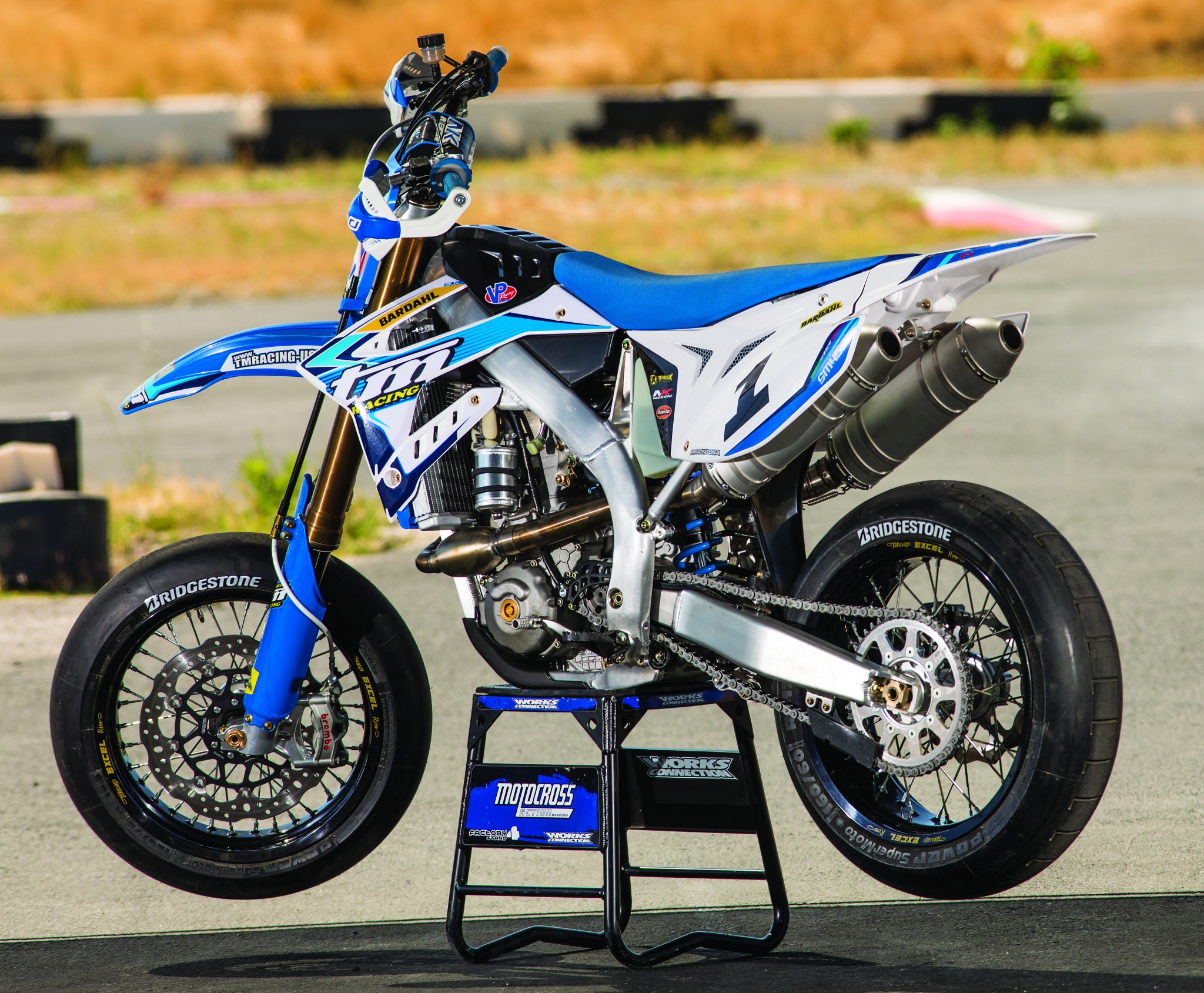
Before the COVID-19 crisis hit, Supermoto series producer DRT Racing had a five -round AMA Supermoto Championship, which included an international stop in Quebec, Canada, and an event in Honolulu, Hawaii, to be held in conjunction with the Monster Truck World Finals. Although American Supermoto is on life support, the sport is still alive in Europe with the FIM Supermoto World Championship and the Superbiker Final in Mettet, Belgium.
Back in the 2000s, most of the major motorcycle manufacturers were producing Supermoto models and selling them to the public, but when Supermoto fizzled in the U.S., the most of the manufacturers pulled out—all except for the European brands, such as TM. It turns out that Alex Serafini, son of TM Motorcycles owner Gastone Serafini, is passionate about Supermoto. The bonus of having your own business (in this case, a motorcycle brand) is that you can do whatever you want with it. With Alex Serafini’s ambitions driving the operation, TM started producing its SMX line of Supermoto race bikes in 2002. Unlike most motorcycle brands that gave up on Supermoto when it started to die off in the U.S., TM pressed forward with the desire to produce a superior Supermoto machine. After years of developing and improving its Supermoto-specific model, TM has earned the Supermoto World Championship nine times in the last decade.
Broken down to it nuts and bolts, Supermoto is more expensive than motocross, but far cheaper than road racing. Another cost to factor in is the rider’s health. Supermoto features off-road sections with jumps and berms, but, for the most part, the off-road sections are comprised of hard-pack dirt similar to flat track. It doesn’t have the whoops, ruts, holes and sand sections that can really beat you up on a motocross track. Although the speeds are fast and the asphalt is hard, riders are often able to slide across the tarmac, pick themselves up after a crash and continue to race. It’s not the speed at which you crash that hurts you, it’s how fast you stop. Most Supermoto riders are suited up in road racing leathers with motocross boots and helmets. As long as they are wearing the proper gear, they can slide down the asphalt or dirt and walk away unscathed.
“WITH ONLY TWO DAYS OF ROAD RACE EXPERIENCE, I WAS OUT OF MY ELEMENT ON THOSE BIKES AND, TO PUT IT MILDLY, I WAS FAR FROM COMFORTABLE. THAT WAS NOT THE CASE WHEN I HOPPED ON THE TM SMX 450FI.”
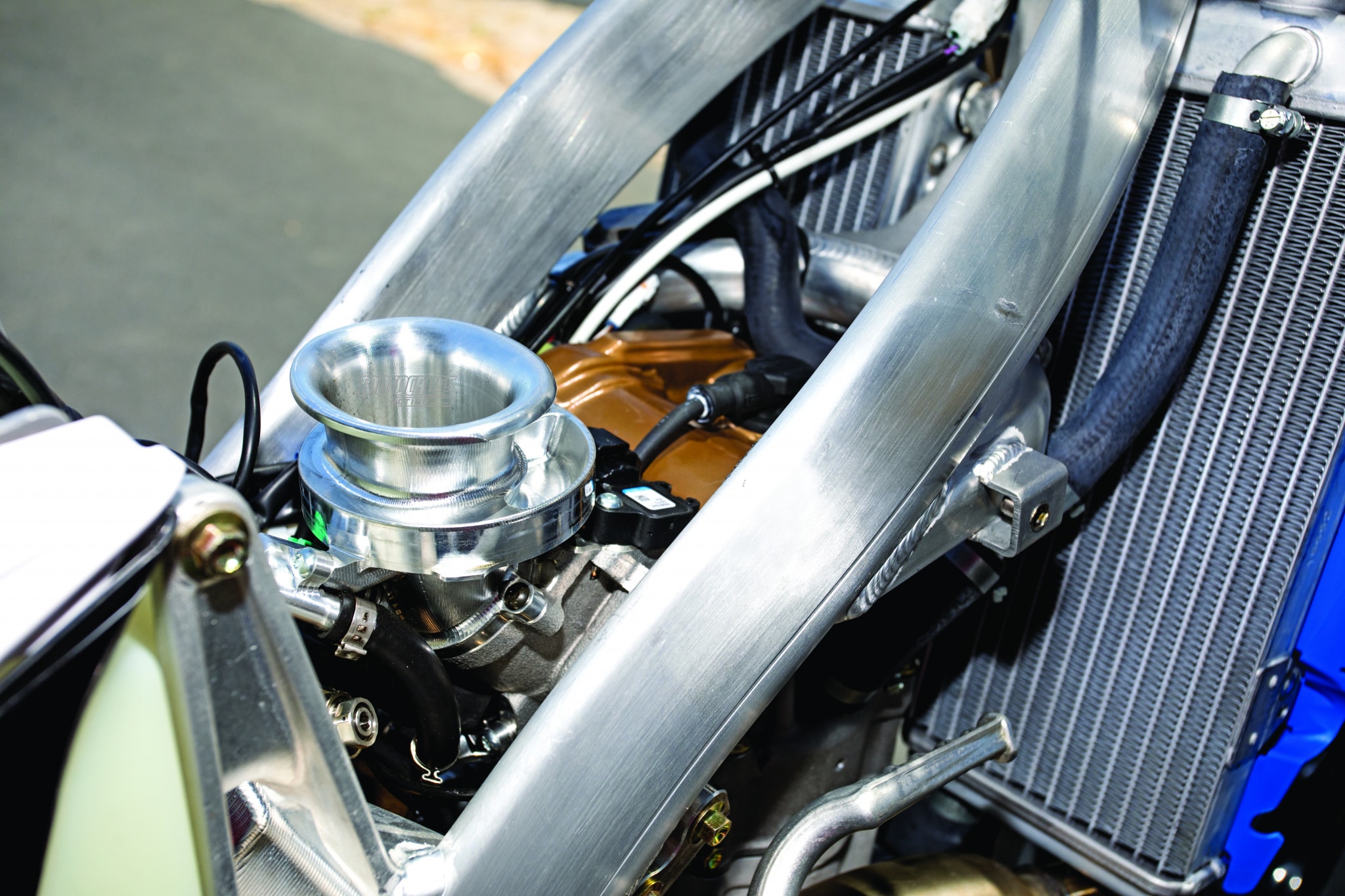
Supermoto is also a great transition for off-road riders who are interested in road racing. The tires last longer. The practice days are cheaper. And, the bikes are more cost-effective. Another great aspect of Supermoto racing is the ability for promoters to set up a track almost anywhere. Large parking lots, kart tracks, baseball stadiums and road courses have been used to host the world’s best Supermoto racers.
As you would guess, a Supermoto bike is a hybrid. TM’s SMX 450FI World Champion Edition was built with a single purpose, which was paradoxically to be dual-purpose. No, it is not a street-legal dual-sport bike with lights and a license plate holder, although TM does offer those models. Instead, the TM SMX 450FI World Champion Edition is race-ready for a track that combines pavement and dirt. As with all TM motocross bikes, you can custom-order your own factory SMX 450FI straight from the manufacturer with all the parts and mods tyou might want. This is one area where TM outperforms every other manufacturer. The “Big Six” won’t give up their secrets, but TM has no problem selling its factory components and modifications to any rider willing to pay for them. The World Champion-version SMX 450FI that the MXA wrecking crew tested sells for $13,595.
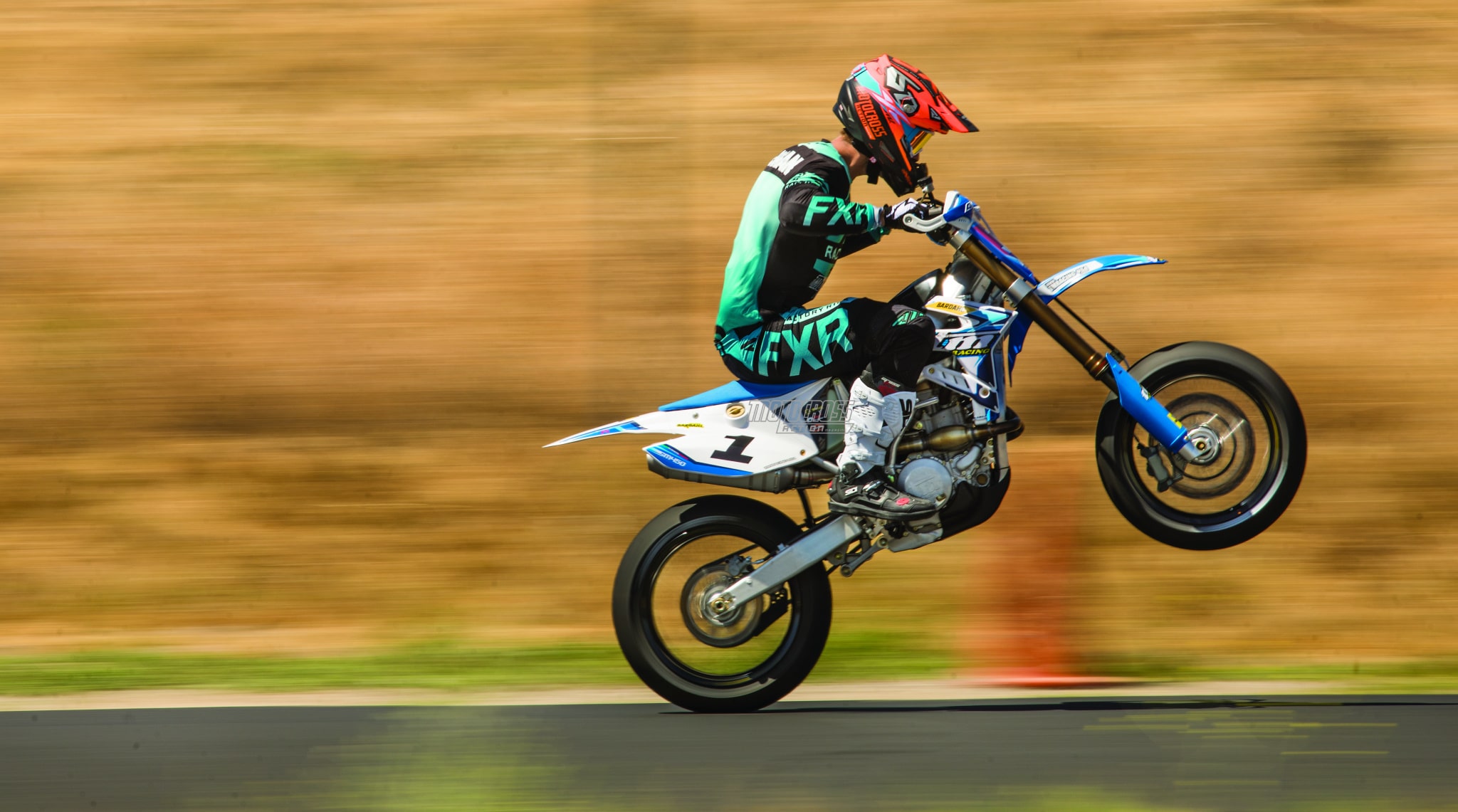
When TM USA importer Ralf Schmidt ordered a TM SMX 450FI for MXA, he made sure to get the Special Edition—with the same factory engine that the TM team runs. The kit engine comes with a laundry list of upgrades that enables it to produce an extra 5 horsepower, bringing the 450FI up to 65 ponies. TM doesn’t mind mixing and matching suppliers when sourcing parts for its bikes, so it didn’t surprise us that the SMX 450FI used Marzocchi forks with an in-house TM shock. The front brake was a massive 305mm wave disc with a Brembo radial master cylinder. The rear brake had a Nissin master cylinder with a 245mm wave disc.
The goal of a Supermoto-specific bike is to be light and low. With lighter wheels and a lighter chain, you have less rotating mass, which helps the bike accelerate quicker and makes it nimble for dipping in and out of corners. Our TM SMX 450FI was equipped with a 16.5-inch front wheel that was 3.5 inches wide. The rear wheel was 17 inches tall and 5 inches wide, but it seemed much wider. To accommodate the extra-wide rear wheel and to shorten the wheelbase, TM used a special Supermoto-specific swingarm. But, even with the wider swingarm, TM still added an extra chain roller to make sure it didn’t slap against the sidewall of the tire. Supermoto suspension is lowered to help with aerodynamics and cornering. Additionally, there are wraparound hand guards to protect the rider’s knuckles and his levers in a crash. A slipper clutch is also used and it’s a big plus on a Supermoto bike, because it eliminates wheel hop on deceleration coming into corners.
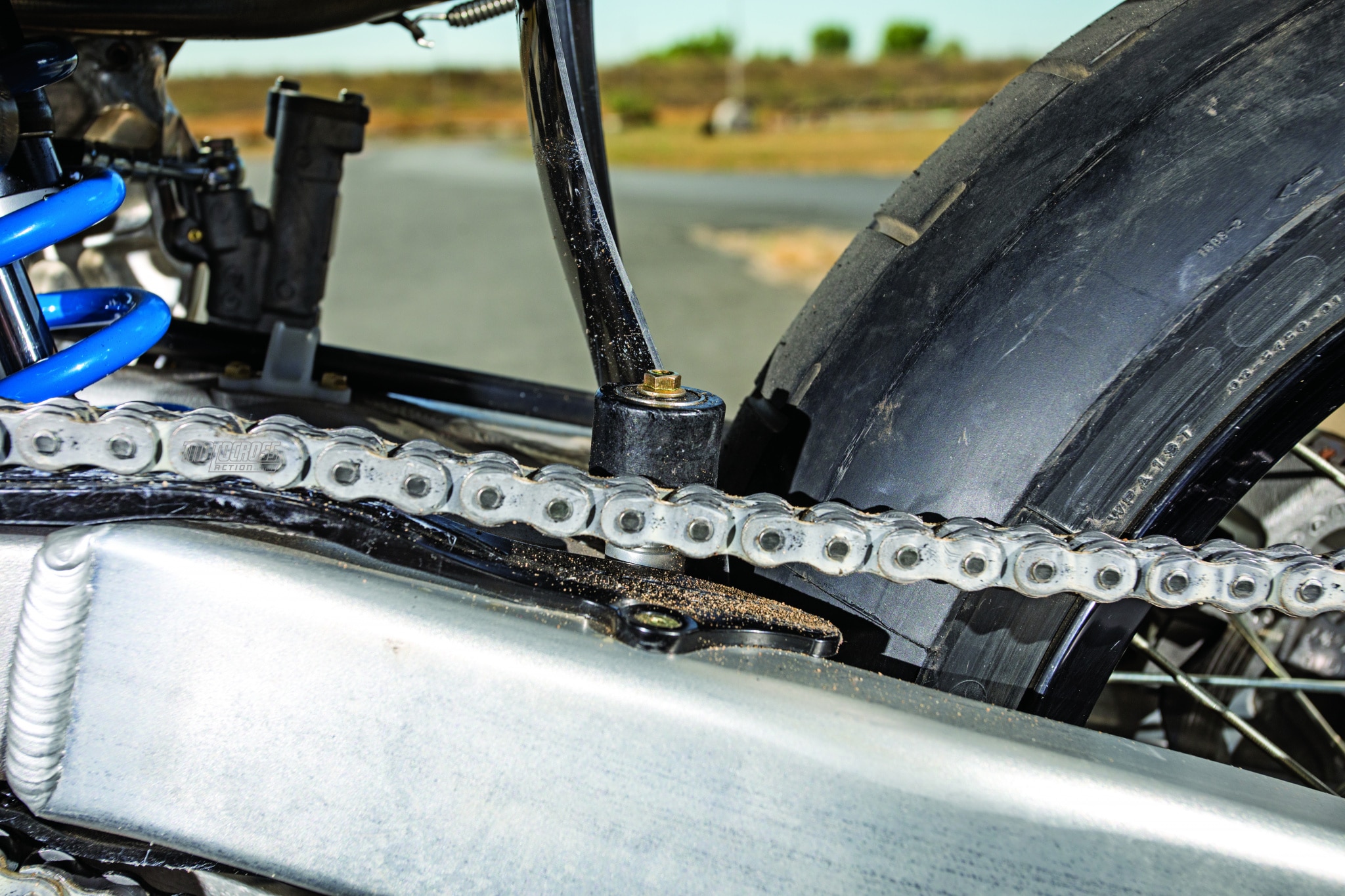
My experience with two wheels on asphalt is very limited, but it’s more than most of my friends’ who currently race Supercross. In 2013, when I was 16, I had the chance to ride Tyler O’Hara’s Harley-Davidson XR1200 at the Sonoma Raceway road course. Then, last year, I tried my hand on a Yamaha R3 and Honda CBR600 at Willow Springs Raceway. With only two days of road race experience, I was out of my element on those bikes and, to put it mildly, I was far from comfortable. That was not the case when I hopped on the TM SMX 450FI. I was immediately relieved by the feeling of the motocross handlebars. Yes, I would be riding on the asphalt, but at least I felt at home because my body positioning, grip and stance were the same as on a dirt bike. I felt like I had a handle on this, especially when I got to the dirt sections that I had seen on old YouTube videos of Jeff Ward racing. But, dirt is not as much of a big deal in modern Supermoto as it was originally, and even when it is, it is as hard as the pavement. Our test Supermoto test track didn’t have a dirt section. I was bummed, but in the end, Daryl Ecklund and I were really only interested in focusing on the asphalt anyway. I promise you, that was enough of a challenge for our first day of Supermoto.
Once on the SMX 450FI, I opened up the throttle and started down the first straightaway. Immediately, I noticed an issue. I was having odd sensations when upshifting. It felt like there was a lag. I was puzzled, but then I remembered that Ralf Schmidt had explained to Daryl and me that the SMX 450FI had a quick-shift setting built into the electronic control unit. There is an electronic sensor on the shift lever that relays data to the ECU the moment you shift. The ECU then quickly cuts the ignition for a split second to allow the bike to shift without the need of the clutch. It turns out that this is an old racing trick, where a rider would hit the kill button at the exact moment that they shifted so that they never had to lift off the throttle. It felt weird when I was riding around the track slowly, but as soon as I started getting on the gas hard and banging through the gears rapidly, I loved it!

My road-racing friend, Tyler O’Hara, is also a Supermoto specialist. I called Tyler on the phone and asked him to give Daryl and me personalized instructions from 400 miles away. Isn’t technology great? The first tip he gave us was to ride the track slowly for three laps before we started pushing. The tires needed to be warmed up to have optimum grip, and since we didn’t have tire warmers, the safest bet was to warm them up the old-fashioned way. Daryl and I took turns on the SMX 450FI, and we got faster with each session. It was a thrill to go wide open and get the feel for how much traction the bike really had. Looking down at the slick tires, it was hard to wrap my mind around the idea of traction, because without knobbies, I just imagined sliding out. Tyler instructed us to use the front brake for 90 percent of our stopping power and to barely touch the rear brake. The rear brake isn’t very precise and can easily lock up, which isn’t a good thing. Tyler wanted us to drift the rear end through the corners like the Pros. He told us to use the rear tire to scrub off speed coming into corners and then back the bike in. I desperately wanted to back it in like a Pro, but I was nervous. It’s kind of like hitting a Supercross triple, skimming the whoops or hitting the biggest jump at your local track the first time. You’ve seen it done and it looks easy, but your brain wants actual proof before it allows your body to fully commit.
“RALF SCHMIDT TOLD US EARLIER IN THE DAY THAT OUR TEST BIKE WOULD GO TO A NEW BUYER AS SOON AS WE WERE DONE RIDING IT OR, IN THIS CASE, CRASHING IT. DARYL APOLOGIZED, BUT RALF LAUGHED AND SAID HE EXPECTED THE CRASH TO COME SOONER OR LATER.”
Racing is all about the pressure of performing. When you tell your friends that you rode a Supermoto bike, the first question they ask is, “Did you back it in?” My answer to that was, unfortunately, “No.” It’s strange, because I can drift my motocross bike on dirt, but the asphalt spooked me with visions of high-sides onto the concrete. The second question they ask is, “Did you crash it?” I can happily say that I didn’t, but Daryl did! Throughout the day, I was loaning him my elbow pads, but he forgot to grab them as he went out for a final session. He was gaining confidence with each session and going faster every lap, but in the end, he got a little too cocky and leaned it over too far. His footpeg hit on the inside shoulder of the corner, lifted the rear wheel enough to break traction and he laid it down. Daryl got away with a little road rash, mostly on his elbows. Daryl felt bad because Ralf Schmidt had told us earlier that the bike had already been sold and would go to the new buyer as soon as we were done riding it or, in this case crashing it. Daryl apologized, but Ralf said that the damage was cosmetic and laughed about how he expected the crash to come much sooner.
Both Daryl and I are former AMA Pro motocross and Supercross racers. We expect to excel on anything with two wheels, so it was a little disheartening not to be the greatest Supermoto racers the world had ever seen after our first day of trying it. But, both of us laughed as we remembered the first time we ever raced on a true-to-life AMA Supercross track. Nothing, not even factory test tracks, prepares you for how steep the jumps are on an actual Supercross track. But, whether it is playing Pac-Man, racing Supercross or backing a Supermoto bike into a black asphalt corner, proficiency comes with practice, dedication and more than one crash. I readily admit that I didn’t use the TM SMX 450FI to its fullest potential, nor did I use my natural talents to their fullest, either. But, thanks to an exceptional Supermoto machine, the help of my friends and Ralf Schmidt’s willingness to let us crash his bike, I know that if I had one more lap, I’d be backing it in.


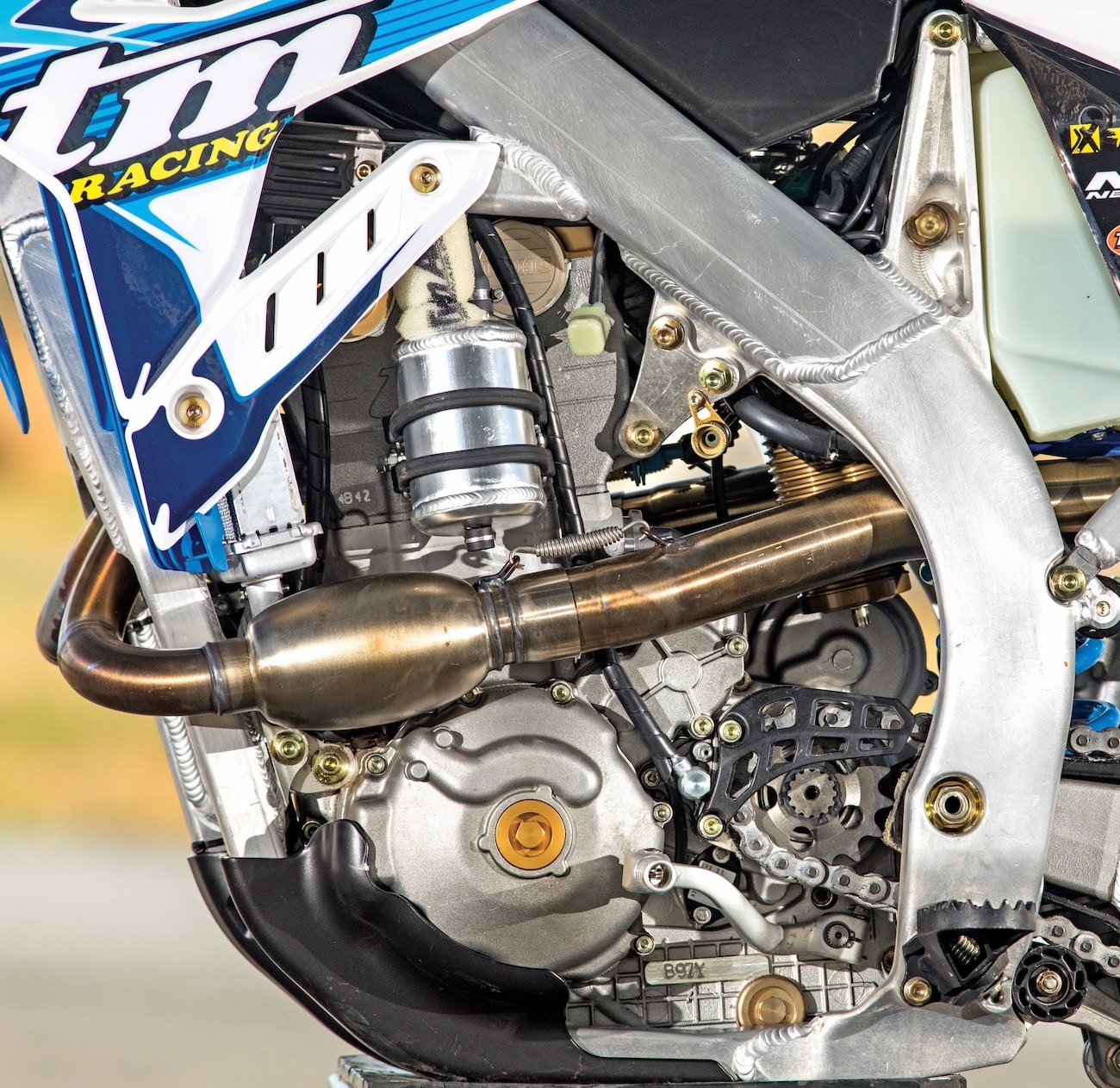
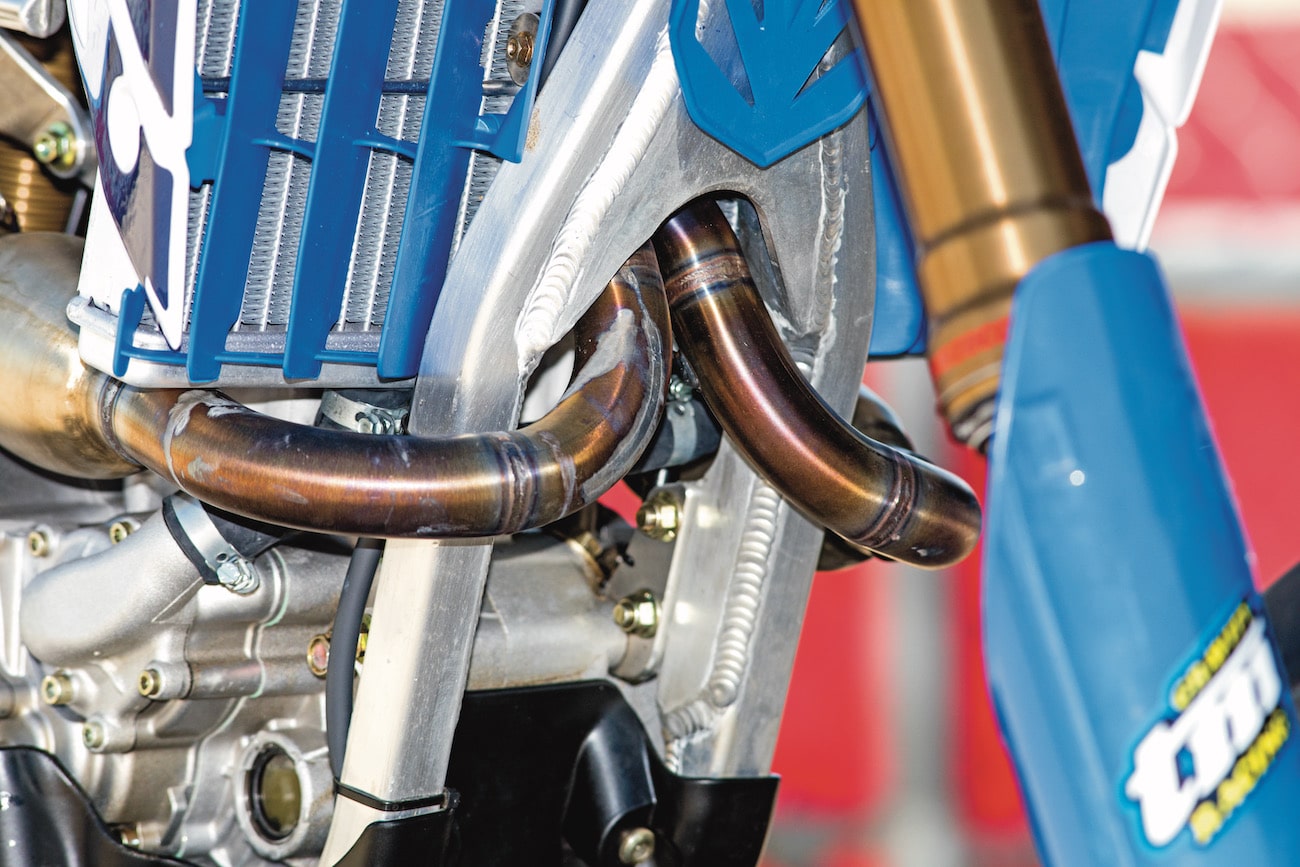

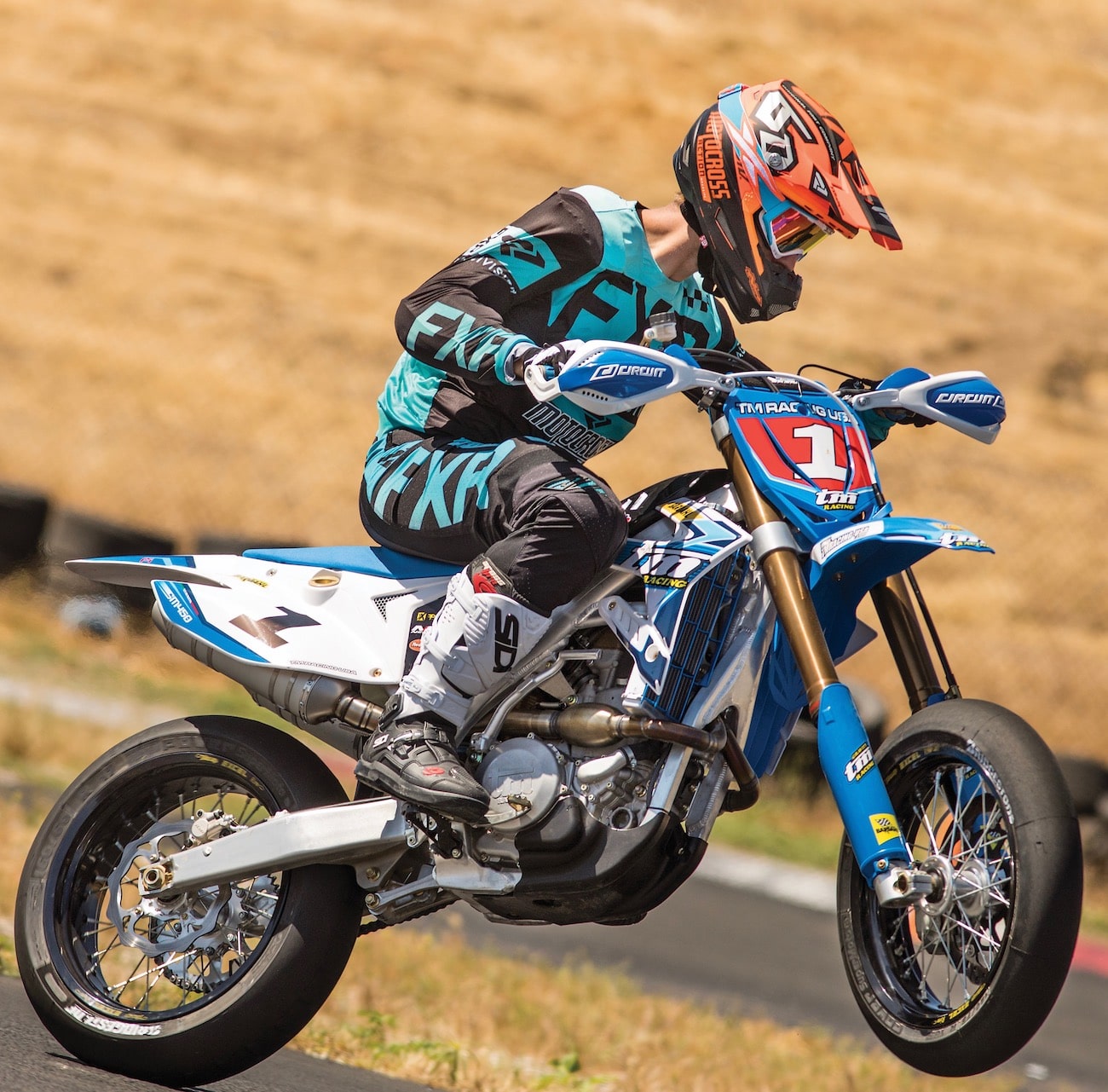
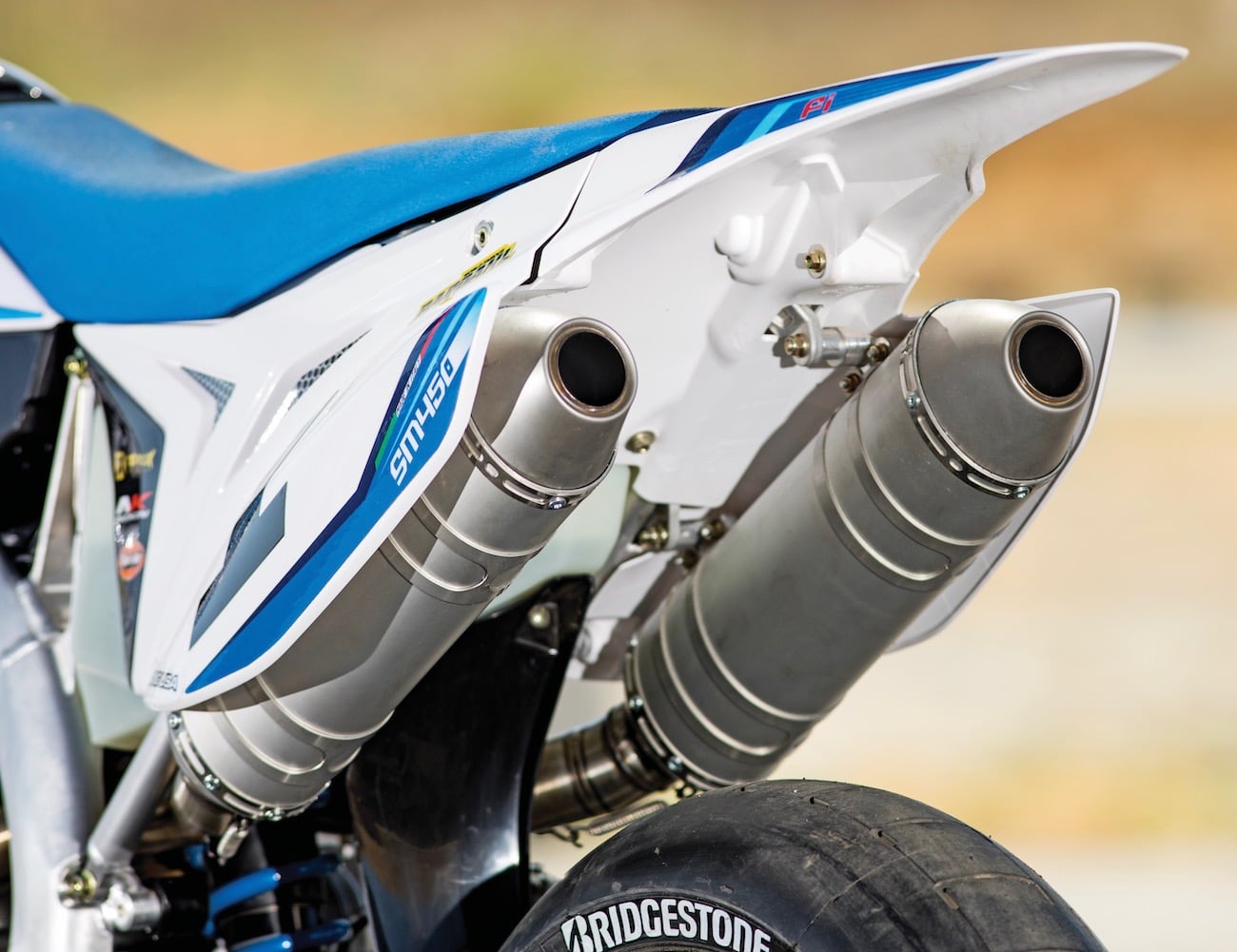




Comments are closed.